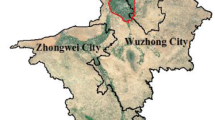Abstract
Considerable proportions of coastal saline tidelands in China have been reclaimed for agricultural land uses in the past 30 years. This study aims to investigate the potential utility of laboratory hyperspectral data for evaluating the reclamation levels of those saline lands. A coastal region of Shangyu City (Zhejiang Province) was used as the study area, which was then grouped into four subzones according to the reclamation history. Soil samples were collected at each subzone, and they were characterized by high electrical conductivity and sand content and low organic matter; the longer the saline lands have been reclaimed, the lower the electrical conductivity and sand content are and the higher the organic matter content is. These changing trends of the soil chemical and physical properties can be indicated by the laboratory reflectance spectra of the soil samples. Stepwise discriminant analysis (SDA) was applied to select and identify six salient spectral bands at 488, 530, 670, 880, 1400, and 1900 nm. Using derived discriminant functions, saline lands with different historical years of reclamation were classified with an overall accuracy of 86.6% in a self-test and 89.3% in a cross validation. Finally, this study suggests that remotely sensed hyperspectral data serve as promising measures to assess the reclamation levels of coastal saline soil, as opposed to time-consuming field investigations.
Similar content being viewed by others
References
E. N. BeDor, N. Goldlshleger, Y. Benyamini, et al., “The Spectral Reflectance Properties of Soil Structural Crusts in the 1.2-to 2.5-m Spectral Region,” Soil Sci. Soc. Am. J. 67, 289–299 (2003).
F. Csillag, L. Pasztor, and L. L. Biehl, “Spectral Band Selection for Characterization of Salinity Status of Soils,” Remote Sens. Environ. 43, 231–242 (1992).
R. L. Dehaan and G. R. Taylor, “Field-Derived Spectra of Salinized Soils and Vegetation as Indicators of Irrigation-Induced Soil Salinization,” Remote Sens. Environ. 80, 406–417 (2002).
J. A. V. Dematte and J. G. Giberto, “Alteration of Soil Properties through a Weathering Sequence as Evaluated by Spectral Reflectance,” Soil Sci. Soc. Am. J. 63, 327–342 (1999).
R. S. Dwivedi and B. R. M. Rao, “The Selection of the Best Possible Landsat TM Band Combination for Delineating Salt-Affected Soils,” Int. J. Remote Sens. 13, 2051–2058 (1992).
L. S. Galvao and I. Vitorello, “Quantitative Approach in the Spectral Reflectance: Lithostratigraphy of the Wind River and Southern Bighorn Basins, Wyoming,” Int. J. Remote Sens. 16, 1617–1631 (1995).
J. Hill and B. Schutt, “Mapping Complex Patterns of Erosion and Stability in Dry Mediterranean Ecosystems,” Remote Sens. Environ. 74, 557–569 (2000).
N. K. Kalra and D. C. Joshi, “Potentiality of Landsat, SPOT and IRS Satellite Imagery for Recognition of Salt-Affected Soil in Indian Arid Zone,” Int. J. Remote Sens. 17, 3001–3014 (1996).
W. A. Klecka, “Discriminant Analysis,” in Statistical Package for the Social Sciences (McGraw-Hill, New York, 1975).
P. Krichnan, J. D. Alexander, B. J. Butler, and J. W. Hummel, “Reflectance Technique for Predicting Soil Organic Matter,” Soil Sci. Soc. Am. J. 44, 1282–1285 (1980).
A. P. Leone and S. Sommer, “Multivariate Analysis of Laboratory Spectra for the Assessment of Soil Development and Soil Degradation in the Southern Apennines (Italy),” Remote Sens. Environ. 72, 346–359 (2000).
The Analysis of Agricultural Materials, MAFF/ADAS Reference Book, No. 427 (Ministry of Agriculture, Fisheries, and Food, London, 1986).
A. Palacios-Orueta and S. L. Uatin, “Remote Sensing of Soil Properties in the Santa Monica Mountains: I. Spectra Analysis,” Remote Sens. Environ. 65, 170–183 (1998).
W. L. Peng, “Synthetic Analysis for Extracting Information on Soil Salinity Using Remote Sensing and GIS: a Case Study of Yanggao Basin in China,” Environ. Manage. 22, 153–159 (1998).
J. D. Rhoades and S. Miyamoto, Soil Testing and Plant Analysis, Ed. by R. L. Westerman (Wisconsin, 1990), pp. 299–366.
Z. Shi, R. C. Wang, M. Huang, and D. Landgraf, “Detection of Coastal Saline Land Uses with Multitemporal Landsat Images in Shangyu City, China,” Environ. Manage. 30, 142–150 (2002).
Z. Shi, M. X. Huang, and Y. Lin, “Physicochemical Properties and Laboratory Hyperspectral Reflectance of Costal Saline Soil in Shangyu City of Zhejiamg Province, China,” Pedosphere 13, 193–198 (2003).
E. R. Stoner and M. F. Baumgardner, “Characteristic Variations in Reflectance of Surface Soils,” Soil Sci. Soc. Am. J. 45, 1161–1165 (1981).
A. Szilaqyi and M. F. Baumgardner, “Salinity and Spectral Reflectance of Soils,” in Proceedings of the Annual Meeting of ASPRS-ACSM (Baltimore, 1991), pp. 430–437.
Author information
Authors and Affiliations
Corresponding author
Additional information
Published in Russian in Pochvovedenie, 2007, No. 10, pp. 1226–1233.
The text was submitted by the authors in English.
Rights and permissions
About this article
Cite this article
Shi, Z., Huang, M.X. Evaluating reclamation levels of coastal saline soil using laboratory hyperspectral data. Eurasian Soil Sc. 40, 1095–1101 (2007). https://doi.org/10.1134/S1064229307100079
Received:
Issue Date:
DOI: https://doi.org/10.1134/S1064229307100079




